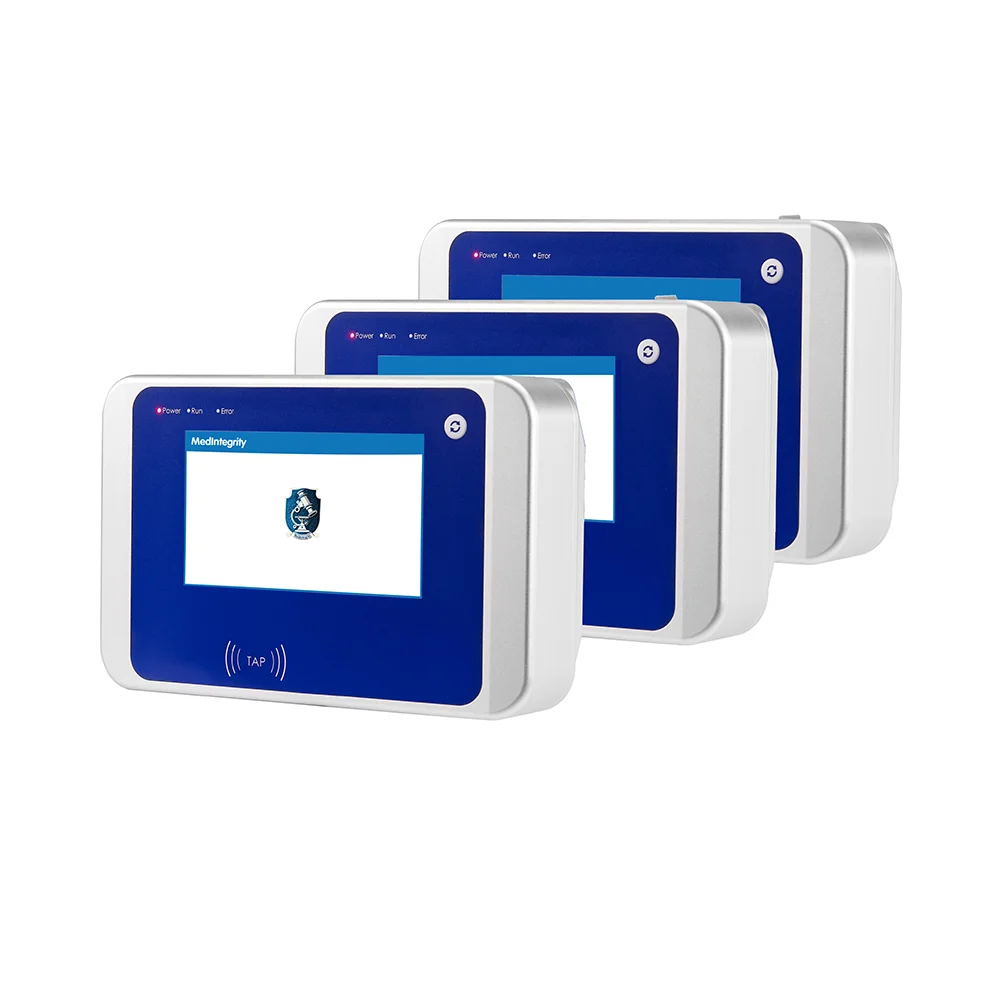How the Pressure Decay Method Ensures Reliable Glove Integrity Testing
How the Pressure Decay Method Ensures Reliable Glove Integrity Testing
In places where safety and cleanliness matter most, checking gloves for holes is vital. At MedIntegrity, we know how crucial it is to test gloves well. This keeps people and products safe. The pressure decay method is a great way to check gloves. It’s accurate and follows strict rules. In this blog, we’ll look at how this method works, where it’s used, and why many industries trust it.

The Importance of Glove Integrity in Various Industries
Gloves act as a strong shield in areas where dirt or germs can cause big problems. They protect product quality, keep workers safe, and meet strict laws. From drug-making to cleanroom work, testing gloves ensures they stay strong. This stops harmful substances from getting through.
Applications of Glove Integrity Testing Across Sectors
Testing gloves is key in many fields, such as:
- Drug Industry: Keeps things germ-free while making medicines, following FDA and other rules.
- Biotech: Shields delicate processes from outside germs.
- Medical Tools: Keeps cleanrooms safe for making sterile devices.
- Food Industry: Stops germs from spreading during food processing.
Our WGT-1200 Glove Integrity Tester fits the tough needs of these fields. It uses wireless tech for easy use in daily work.

Risks Associated with Compromised Gloves
A hole in a glove can cause serious issues, like:
- Product Contamination: Germs or dirt sneak into clean areas.
- Rule-Breaking: Failing inspections due to weak protection.
- Worker Danger: Harmful substances touch workers’ skin.
- Money Loss: Recalls or stopped work due to contamination.
Using strong testing methods like pressure decay lowers these risks. It keeps things safe and follows rules.
An Overview of the Pressure Decay Method
The pressure decay method is a popular way to test gloves. It’s valued for being simple, precise, and meeting standards like GB/T 25915.7-2010 and ISO 14644-7:2004. This method finds holes by checking air pressure changes in a sealed glove. It’s a safe way to ensure gloves are strong without damaging them.
Key Principles Behind the Pressure Decay Technique
The pressure decay method follows these steps:
- Filling with Air: The glove is filled with air or safe gas to a set pressure.
- Settling: The system waits for the pressure to steady. This accounts for glove stretch or room conditions.
- Checking: The tester watches for any pressure drop over time. A drop means a possible hole.
- Reviewing: A big pressure drop shows a hole. Steady pressure means the glove is good.
This method is very exact. It can find tiny holes that might weaken a glove.
Advantages of Using the Pressure Decay Method for Glove Testing
The pressure decay method has many benefits:
- Very Sensitive: Spots even the smallest holes, giving trustworthy results.
- Safe for Gloves: Doesn’t harm gloves, so they can be used after testing.
- Follows Rules: Meets laws, including 21 CFR Part 11 for digital records.
- Easy to Use: Simple to set up and run, as shown by our WGT-1000 Online Glove Integrity Tester.
These perks make pressure decay a top pick for industries that value safety and speed.
Steps Involved in Pressure Decay Testing for Gloves
Doing a pressure decay test requires clear steps to get accurate results. Here’s how it works:
Preparing the Glove for Testing
- Checking: Look at the glove for any clear damage or wear.
- Attaching: Fasten the glove to the tester’s port. Make sure it’s sealed tight.
- Setting Up: Confirm the tester, like our WGT-1200, is set to the right pressure levels.
Good preparation avoids wrong results and makes tests reliable.
Conducting the Pressure Decay Test
- Filling: The tester pumps air into the glove to the right pressure.
- Waiting: The system pauses to let the pressure settle.
- Measuring: The tester checks for pressure changes over a set time.
- Recording: Results are saved. Our testers store over 12,000 test records.
Our wireless testers make this process smooth. They send data instantly.
Interpreting Test Results for Accuracy and Reliability
Test results depend on pressure changes:
- Pass: Little or no pressure drop. The glove is strong.
- Fail: A big pressure drop. This means a hole, so replace the glove.
Our systems give clear, trackable results. They meet data safety standards.
Factors Influencing the Effectiveness of Pressure Decay Testing
Several things can affect how well pressure decay testing works. Knowing these helps get better results.
Material Properties and Their Impact on Testing Outcomes
Glove materials, like nitrile, latex, or neoprene, change how tests work:
| Material | Features | Testing Notes |
| Nitrile | Tough, resists chemicals | Needs stronger pressure for good results |
| Latex | Stretchy, bendable | Careful not to use too much pressure |
| Neoprene | Heat-proof, flexible | May need longer settling time |
Choosing the right tester settings for each material gives dependable results.
Environmental Conditions and Their Role in Test Accuracy
Room conditions, like heat or dampness, can affect pressure readings:
- Temperature: Changes in heat can shift pressure. Tests need steady conditions.
- Humidity: Wet air can change glove stretch. This affects settling time.
- Air Cleanliness: Dust can mess with sealing. Tests should happen in clean areas.
Our testers work well in different conditions. They give steady results.
Performance Qualification of Glove Integrity Tester Systems
A good glove tester must meet high standards. This ensures results are consistent and correct.
Criteria for Evaluating a Reliable Tester System
When picking a tester, look for:
- Accuracy: Strong sensors to find tiny holes.
- Rule-Following: Meets FDA, GMP, and 21 CFR Part 11 standards.
- Flexibility: Works with different glove types and sizes.
- Data Handling: Stores records safely and tracks changes.
Our WGT-1200 and WGT-1000 models shine in these areas. They offer top features for many uses.
Ensuring Consistency and Repeatability in Test Results
To keep results steady:
- Regular Checks: Make sure the tester works within set limits.
- Worker Training: Teach users to avoid mistakes.
- Upkeep: Routine checks stop equipment issues.
We offer full support, including setup guides and standard procedures. This keeps your testing process strong.
MedIntegrity: A Trusted Supplier of Glove Integrity Testers
At MedIntegrity, we’re proud to lead in providing precise testing tools for the drug industry. Our glove testers are built for reliability and ease. They help our customers keep safety and rule-following at the highest levels.
Features and Benefits of MedIntegrity’s Products
Our testers, like the WGT-1000 and WGT-1200, provide:
- Wireless Tech: Shares data instantly for easy management.
- Built-in Pump and Battery: Makes testers portable and handy.
- Precise Sensors: Finds holes quickly and accurately.
- Rule-Friendly Features: Secure access and digital signatures for 21 CFR Part 11.
These features make our testers a go-to choice for clients like BeiGene USA, Inc., and Sunny Pharmaceutical.
Why Choose MedIntegrity for Your Testing Needs
We stand out for our focus on quality and support:
- Proven Skill: Years of work in glove and filter testing.
- Worldwide Reach: Helping thousands of drug companies globally.
- Full Support: From setup to ongoing care, we’re here.
Contact us to see how we can help with your testing needs.
Conclusion: Ensuring Safety and Reliability Through Effective Glove Testing
The pressure decay method is a key tool for checking glove strength. It’s precise, follows rules, and is easy to use. By using this method and working with a trusted supplier like MedIntegrity, you can protect your work, keep workers safe, and meet standards. Visit our homepage to see all our testing tools.
Frequently Asked Questions (FAQs)
What is the main purpose of glove integrity testing?
The main goal of glove testing is to check that gloves used in clean areas, like drug-making or cleanrooms, have no holes. This ensures they block germs and dirt. It keeps products and workers safe while following strict rules.
How does the pressure decay method differ from other testing methods?
The pressure decay method uses air pressure to find holes without damaging gloves. Unlike water tests or visual checks, it’s more sensitive. It spots tiny holes, needs no extra tools, and gives trackable data. This makes it faster and better for meeting rules like 21 CFR Part 11.
Can pressure decay testing be applied to all types of gloves?
Yes, pressure decay testing works for most gloves, like nitrile, latex, or neoprene. But the tester must be set up for each material’s traits. For example, pressure levels and settling times need tweaks based on how stretchy or thick the glove is. This ensures accurate results.







